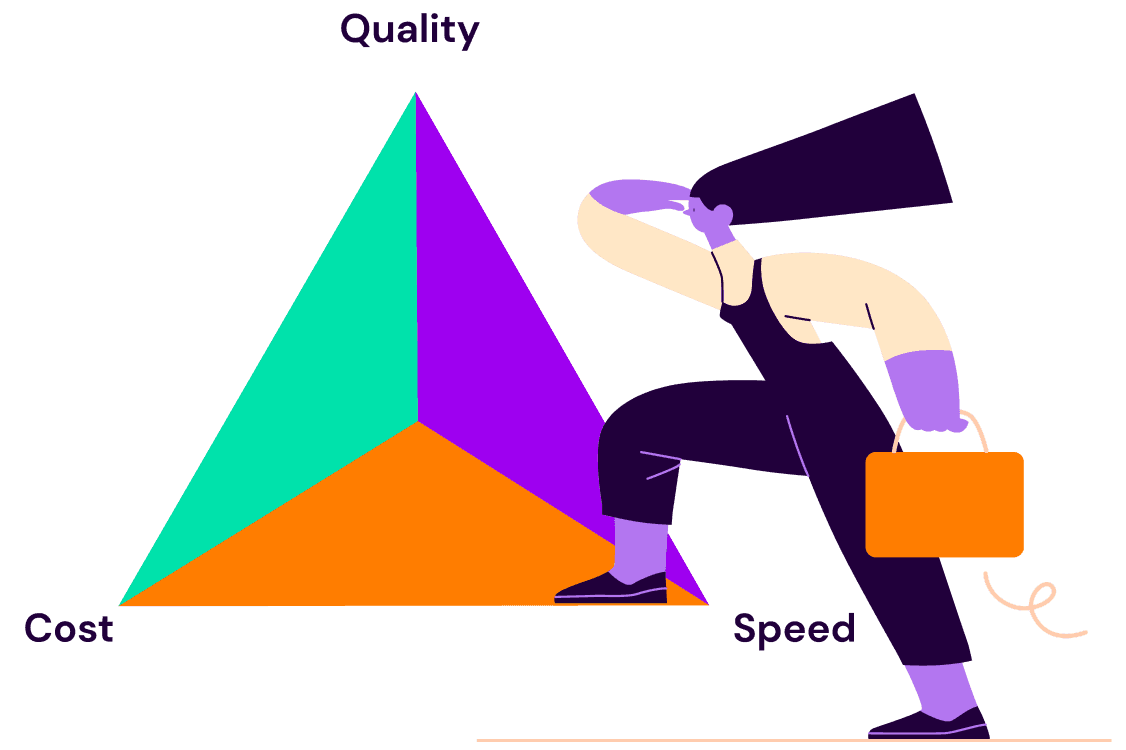
Back to blogs

An Intro to Talent Intelligence: How It Works and How to Profit From It
The talent landscape has shifted rapidly over the last several years. Employee churn rates are high, the skills shortage keeps growing, and AI has become so sophisticated that talent teams can gather more data than they know what do to with. With so many challenges in motion, it’s easy to understand why organizations are struggling to hire and retain a workforce that supports their business goals—but talent intelligence could be the way through.
In this overview, you’ll learn what talent intelligence is and why CHROs and talent leaders are leveraging it to hire smarter, keep their high-performing talent, and keep their talent adaptable to any changes that come their way.
What is talent intelligence?
Talent intelligence is the process of collecting, analyzing, and operationalizing data that stems from internal and external talent pools, including those of competitors like market insights. For example, organizations can collect data from a variety of sources around diversity hiring efforts, sourcing efficiency, nurture engagement, retention rates, internal hiring, and employee satisfaction scores. They can then use this data in its entirety to make informed, actionable decisions around their short- and long-term talent roadmaps.

Suggested Reading: Why Data-Driven Recruiting Leads to Smarter Talent Strategies
Talent intelligence empowers CHROS and talent leaders to make data-driven decisions about their hiring and retention strategies and tie them closely to business impact.
Why is talent intelligence important to an organization’s success?
The talent function has historically been separated into two pillars: talent acquisition and talent management. Talent acquisition is often the pillar that organizations focus on the most, while talent management is treated as a nice-to-have. In today’s unpredictable talent landscape, this fragmented approach to talent strategy is outdated. Businesses are losing high-performing talent to competitors and it’s becoming increasingly difficult to hire talent with needed skills.
To stay competitive and relevant with their employees and candidates, organizations need a comprehensive approach to their talent where talent acquisition and talent management no longer exist separately. Talent intelligence offers this unified view, bringing together employee data and external talent pool data to enable teams to plan for immediate needs and evolve with future needs of the business.
Redefining the Role of the Recruiter: From Sourcing Expert to Talent Advisor
Download the reportA key here is that talent intelligence helps organizations understand their existing workforce so they can mobilize the talent they already have when business priorities change. Tapping into your employees—who already have intimate knowledge of your business or product—can solve the stickiest of talent issues much faster than continually hiring externally when it may not be necessary. Organizations can approach short-term needs (e.g., this employee with this specialty skill fits this open role) and long-term needs (e.g., can this employee learn this skill to start this crucial role in six months?) with more intention and efficiency.
Examples of questions that talent intelligence can help answer
Without the right data available, talent teams suffer from a lack of knowledge that prevents their strategies from evolving. Organizations remain stagnant or scramble to keep up with evolving needs, which impedes their path to becoming an employer of choice where people want to work and stay for years to come. Talent intelligence helps teams get to the root of their toughest challenges by providing insight into questions such as:
Where do I have a skills gap?
What are adjacent skills for this role?
How engaged are employees?
Who is at risk of leaving the organization?
What roles are in high demand within the organization and at similar or competitor companies?
What makes candidates choose or reject potential employers?
What pay range and benefits are being offered for similar roles in the market?
What role expectations do similar companies have from candidates?
How are similar organizations approaching culture, social justice, equity, and other intangible benefits?
What are the role-specific and organization-wide benchmarks for metrics such as time to fill, cost per hire, turnover rates, and time to productivity?
What recruiting channels are best suited for each type of role in the industry?
Where do the best candidates come from?
Why do employees quit?
What retention methods are the most effective in the industry?
What sort of opportunities do employees look for after leaving my company?
Talent intelligence helps organizations refine and innovate their strategies to remain agile, forward-thinking, and competitive with candidates and existing employees.
What data sources feed talent intelligence?
The data that informs talent intelligence typically comes from five sources:
1. Recruiting platforms
A candidate’s first interaction with potential employers is typically captured across recruiting solutions. If you’re using an AI-assisted solution, you can further analyze recruitment data captured through candidate profiles on professional and social networks, resumes, interview data, offer acceptance, and past interactions.
2. Background verification
Background verification reports provide data on candidates and their past employers. This is ideal for role-specific insights into past pay, responsibilities, and job expectations.
3. Core HR solutions
Core HR solutions or HCM (Human Capital Management) platforms can offer an in-depth look into an organization's internal talent. For example: payroll information, data of last promotions, time spent in the role and the organization, performance metrics and impact, exits and qualitative data around exit interviews, and absenteeism.
4. Job boards and aggregation sites
Industry-relevant job boards and aggregator sites like Glassdoor can provide insight into labor market trends, helping you to establish benchmarks on salary ranges, job responsibilities, number of openings and applicants, competitor reviews, and job descriptions.
In addition to quantifiable data, you can gather information on the type of candidates who typically apply for specific roles. Organizations can use this data to fine-tune their messaging and craft inclusive job descriptions to build diverse candidate pipelines.
5. ATS and employee networks
Applicant tracking systems and employee networks gather data around diverse candidates who already have a connection to the organization. This data can be used to expand the sourcing funnel and create more opportunities to diversify the talent pool.
Talent intelligence platforms: How to leverage talent data
There’s so much talent data available—that much is clear—but how can talent teams best capture it all to guide strategy? Talent intelligence platforms like SeekOut can integrate with various data sources and merge all that information into one platform that can be analyzed and acted upon.
Powered by AI, these platforms provide insights based on thousands of data points captured throughout the candidate and employee journey. For your recruiters, talent intelligence platforms are the best resource to uplevel their role into trusted talent advisors to your organization.
Develop existing talent to better support your business goals
Talent intelligence platforms help to create a cultivated internal mobility process by giving employers deep insight into employee performance and satisfaction.

Suggested reading: 7 Strategies to Drive Internal Mobility
Recruiters and HR leaders can identify high performers and at-risk employees, enabling them to promote, reward, recognize, and retain people who have an outsized impact on the business. CHROs and talent leaders can further analyze this data to understand why employees may want to quit or understand the drivers of high-performance to mitigate attrition and build on growth.
Internal talent data also informs more strategic decisions around crucial questions, such as:
Are underrepresented employees being provided with enough opportunities to grow?
Is the executive team diverse enough?
Is the organization supporting employees’ individual ambitions and needs?
Talent intelligence gives a competitive advantage to organizations that use it to refine their hiring process. It brings the most passionate and qualified people to the organization in the shortest amount of time and allows you to understand how to keep them there.
Hire better-qualified candidates with richer insights into their abilities
Traditional sourcing relies heavily on job titles and keywords, which can limit the scope of profiles that match. For example, searching “Java Developer” will miss candidates who don’t have the exact keyword in their resume. Results can also include poor matches where the keyword may exist, but the candidate doesn’t have the required skills or aptitude for the role.
Platform capabilities like AI talent matching go beyond keywords and job titles to offer a more holistic view of candidates’ skills and experience. This is because AI has a much wider “understanding” of the search context. With a better understanding of the candidate’s breadth of skills and capabilities, recruiters can improve the quality of candidate interactions and shorten time-to-fill because they’re not wasting efforts speaking with anyone who is underqualified or uninterested.
Re-engage with former candidates to shorten the hiring cycle
A major pitfall of sourcing platforms is that past resumes and silver medalist candidates are often overlooked. Over the years, organizations amass thousands of resumes that get lost once a role is filled. When the position opens again in the future, recruiters start the process all over again.
Traditional platforms aren’t designed to reassess past applicants, but talent intelligence platforms “learn” to discover qualified candidates from the pool of past applicants. With AI, these platforms are constantly refreshing data, so not only can you surface relevant candidates who applied for a role in the past, but you’ll also have access to their most up-to-date qualifications and work history.
Signs to invest in talent intelligence platform
Given the shifting talent environment, the time to unify your talent strategy is now. But there are some tell-tale signs your organization needs a talent intelligence platform:
Increasing turnover rates
Longer hiring times
Declining employee engagement and commitment
Higher cost of recruitment
These continued challenges hint that your traditional methods are becoming obsolete and it’s time to update them. A data-driven approach with talent intelligence will help you directly solve these challenges:
Stay ahead of labor market trends to fill roles faster.
Perform strategic workforce and succession planning to build, buy, or borrow talent and fulfill your company strategy with more accuracy.
Support internal talent mobility to keep high-performing people
Overcome skills gaps faster to keep innovation moving forward.
If any of these challenges resonate with you, it’s worth at least exploring talent intelligence platforms to further understand how one can help your business’s specific needs and provide the right ROI.
How to assess a talent intelligence platform
Researching new technologies can be overwhelming, but we put together a checklist to help keep you organized and bring clarity to the process. Download a Buyer’s Checklist to Talent Intelligence platforms to discover impactful features to look for and what questions to ask providers along the way.
See us in action
Learn how SeekOut unifies people data to help organizations reach their talent goals
Request a demo



